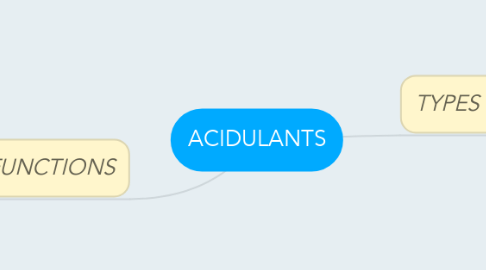
1. FUNCTIONS
1.1. pH control agents
1.1.1. To obtain certain pH range in product formulation
1.1.2. Maintain the acidic pH and the tartness of carbonated beverages
1.1.3. Buffering capacity
1.2. Preservatives
1.2.1. Stop growth or enhances the effectiveness of heat sterilization or the antimicrobial effects of solutes.
1.2.2. Antibrowning agents to maintain the normal flavour, colour & texture of canned fruits and vegetables.
1.3. Chelating agents/Antioxidant Synergists
1.3.1. Chelation : prevents the metal ions from reacting with other materials or from acting as as a catalyst for reactions.
1.3.1.1. To retard the enzymic browning of fruits and vegetables.
1.3.2. Synergists : For antioxidants in the preservation of fats & oils, and in food products containing fatty compounds.
1.4. Flavour Adjuncts
1.4.1. Modify/Enhance food flavours
1.4.2. Add the tartness to balance the excessive sweetness ("brix acid ratio")
1.5. Control of Gelation & Coagulation
1.5.1. Play a significant role in the gelation of pectin and algins.
1.5.2. Provide precise pH control
2. TYPES OF FOOD ACIDS
2.1. ORGANIC ACIDS
2.1.1. Amino acids
2.1.2. Lactones
2.1.2.1. Ascorbic acid
2.1.2.2. Gluconolactone
2.1.3. Fatty acids
2.1.3.1. Sorbic acid
2.1.3.2. Caprylic acid
2.1.3.3. Butyric acid
2.1.4. Phenolic acids
2.1.4.1. Benzoic acid
2.1.5. Carboxylic acids
2.1.5.1. Monocarboxylic acids
2.1.5.1.1. Acetic acid
2.1.5.1.2. Propionic acid
2.1.5.1.3. Lactic acid
2.1.5.2. Dicarboxylic acids
2.1.5.2.1. Malic acid
2.1.5.2.2. Tartaric acid
2.1.5.2.3. Adipic acid
2.1.5.2.4. Fumaric
2.1.5.3. Tricarboxylic acids
2.1.5.3.1. Citric acid
2.2. INORGANIC ACIDS
2.2.1. Phosphoric acid
2.2.2. Hydrochloric acid
2.2.3. Sulfuric acid
